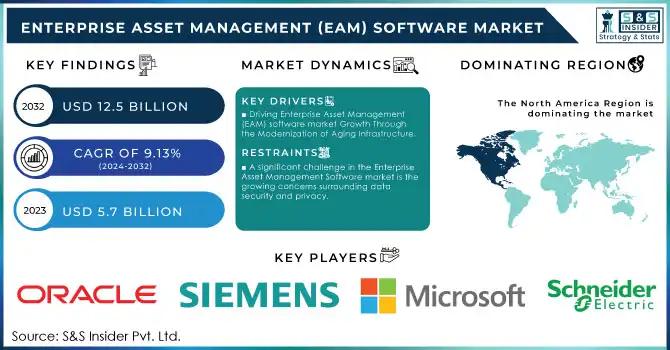
The Enterprise Asset Management (EAM) Software market size was valued at USD 5.7 Billion in 2023 and is expected to reach USD 12.5 Billion by 2032 and growing at a CAGR of 9.13% over the forecast period 2024-2032.
Market Summary
Enterprise Asset Management (EAM) software plays a pivotal role in modern enterprise operations by enabling organizations to manage the entire lifecycle of physical assets, ensuring optimal use, reduced operational costs, and improved asset reliability. The software supports businesses in sectors such as manufacturing, energy, transportation, healthcare, and government in planning, tracking, and maintaining assets efficiently.
In 2023, the global EAM market witnessed significant expansion due to the adoption of cloud-based solutions, growing emphasis on predictive maintenance, and increasing investments in digital transformation. With businesses aiming to maximize asset performance while ensuring compliance and sustainability, EAM solutions have become an integral part of strategic planning.
Get Sample Report: https://www.snsinsider.com/sample-request/2177
Key Players
Some of the Major Players Enterprise Asset Management (EAM) Software Market with product:
IBM Corporation (IBM Maximo Asset Management)
SAP SE (SAP EAM)
Oracle Corporation (Oracle EAM)
Infor (Infor EAM)
IFS AB (IFS EAM)
ABB Ltd. (ABB Ability Asset Suite)
Siemens AG (Siemens COMOS)
Schneider Electric (Avantis EAM)
Microsoft Corporation (Microsoft Dynamics 365 Supply Chain Management)
Hexagon AB (HxGN EAM)
Bentley Systems, Incorporated (AssetWise)
GE Digital (Asset Performance Management)
Asset Works LLC (AssetWorks EAM)
eMaint Enterprises LLC (a Fluke Company) (eMaint CMMS)
Dude Solutions, Inc. (Asset Essentials)
Ultimo Software Solutions (Ultimo EAM)
Accruent (Maintenance Connection)
IBM Tririga (Tririga Facilities Management)
Ramco Systems (Ramco EAM on Cloud)
MPulse Software, Inc. (MPulse Maintenance Software)
Market Analysis
The EAM software market is evolving rapidly, characterized by technological advancements and a growing focus on data-driven asset management. Cloud-based EAM systems are gaining substantial traction, offering real-time monitoring, easier deployment, and cost-effective scalability compared to on-premise solutions. Integration of Internet of Things (IoT), artificial intelligence (AI), and machine learning (ML) is further enhancing the capability of EAM platforms, enabling predictive analytics and smarter decision-making.
The increasing demand for reducing equipment downtime, optimizing resource usage, and managing aging infrastructure is contributing to the steady growth of the market. Enterprises are prioritizing investments in systems that can streamline maintenance workflows, reduce unplanned failures, and provide actionable insights into asset performance.
Market Scope
The market scope for EAM software encompasses a wide range of industries, including:
Manufacturing: Emphasis on production uptime and regulatory compliance.
Energy and Utilities: Need for effective maintenance of critical infrastructure.
Transportation and Logistics: Requirement for fleet management and asset tracking.
Healthcare: Managing medical equipment and ensuring regulatory compliance.
Government and Public Sector: Infrastructure asset tracking and budgeting.
The scope is further broadened with the expansion of mobile EAM applications, which empower field workers with access to asset data, maintenance schedules, and work orders from remote locations.
Market Drivers
Several key drivers are propelling the growth of the EAM software market:
Rising Need for Asset Lifecycle Optimization: Organizations are increasingly focusing on extending asset life and reducing lifecycle costs.
Digital Transformation Initiatives: Rapid digitization across industries is leading to higher adoption of smart EAM systems.
Shift Toward Predictive Maintenance: Companies are moving from reactive to predictive maintenance models, powered by AI and IoT.
Increased Focus on Compliance and Risk Management: Regulatory frameworks in sectors such as healthcare and utilities are encouraging the adoption of EAM for compliance and auditing.
Growing Demand for Cloud-based Solutions: Scalability, flexibility, and reduced upfront costs are making cloud deployments more popular.
Get Enquiry Report: https://www.snsinsider.com/enquiry/2177
Key Segmentation
By Deployment Model
On-premise
Cloud -Based
Hybrid
By Organization Size
Small and medium-sized businesses (SMEs)
Large Enterprises
By Industry
Manufacturing
Utilities
Transportation
Oil and gas
Other industries
Key Factors
Technology Integration: Incorporation of AI, IoT, and analytics is significantly improving the functionality and efficiency of EAM platforms.
Mobile Accessibility: The rise of mobile applications for asset tracking and maintenance has improved real-time decision-making and field operations.
User-Friendly Interfaces: Intuitive dashboards and customizable features are enhancing user adoption across organizations.
Customization and Scalability: Solutions tailored to industry-specific needs and scalable architectures are attracting a broad user base.
Regional Analysis
North America currently leads the EAM software market, driven by strong technological infrastructure, early adoption of digital solutions, and the presence of major industry players. The region’s focus on optimizing operational efficiency and ensuring compliance has fostered substantial demand for EAM platforms.
Europe follows closely, with increased government regulations and industrial automation initiatives pushing enterprises toward efficient asset management.
Asia Pacific is expected to witness the highest growth rate over the forecast period. Rapid industrialization, infrastructure development, and the rise of smart cities in countries like China, India, and Japan are contributing to the growing demand for EAM software. Moreover, increasing IT investments in emerging economies are creating new opportunities for market expansion.
Latin America and the Middle East & Africa are also poised for moderate growth, supported by the gradual modernization of industrial sectors and a growing awareness of the benefits of EAM solutions.
Recent Developments
The EAM market has seen a wave of strategic developments in recent years:
Technology Upgrades: Leading vendors are enhancing their platforms with AI-driven analytics, digital twin capabilities, and IoT integration to provide smarter asset management tools.
Mergers and Acquisitions: Market consolidation through M&A activities is helping companies expand their customer base and improve product offerings.
Partnerships and Collaborations: Collaborations between EAM vendors and cloud service providers have led to the development of more scalable and integrated solutions.
Industry-Specific Solutions: Tailored offerings for verticals such as oil & gas, energy, and transportation are gaining traction, addressing unique asset management needs.
Get Complete Report: https://www.snsinsider.com/reports/enterprise-asset-management-software-market-2177
Conclusion
As businesses continue to strive for efficiency, reliability, and sustainability, Enterprise Asset Management software will play a crucial role in reshaping asset-intensive industries. The projected growth to USD 12.5 billion by 2032 underscores the increasing importance of intelligent asset management in the digital age. With innovations and strategic investments fueling the market, EAM solutions are set to become indispensable tools for organizations worldwide.





















Write a comment ...